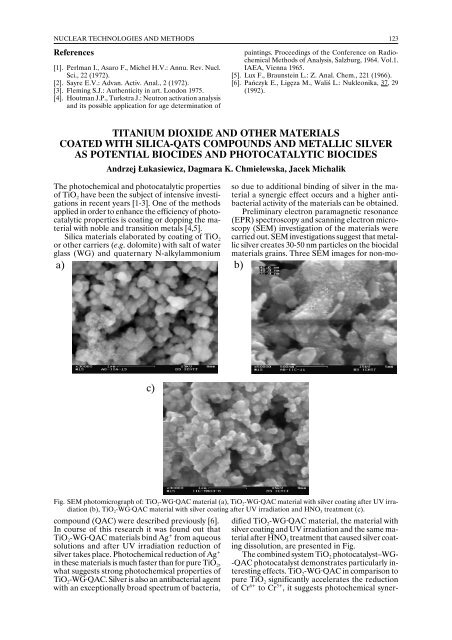annual report annual report annual report annual report 2005
annual report annual report annual report annual report 2005
annual report annual report annual report annual report 2005
You also want an ePaper? Increase the reach of your titles
YUMPU automatically turns print PDFs into web optimized ePapers that Google loves.
NUCLEAR TECHNOLOGIES AND METHODS 123<br />
References<br />
[1]. Perlman I., Asaro F., Michel H.V.: Annu. Rev. Nucl.<br />
Sci., 22 (1972).<br />
[2]. Sayre E.V.: Advan. Activ. Anal., 2 (1972).<br />
[3]. Fleming S.J.: Authenticity in art. London 1975.<br />
[4]. Houtman J.P., Turkstra J.: Neutron activation analysis<br />
and its possible application for age determination of<br />
paintings. Proceedings of the Conference on Radiochemical<br />
Methods of Analysis, Salzburg, 1964. Vol.1.<br />
IAEA, Vienna 1965.<br />
[5]. Lux F., Braunstein L.: Z. Anal. Chem., 221 (1966).<br />
[6]. Pańczyk E., Ligęza M., Waliś L.: Nukleonika, 37, 29<br />
(1992).<br />
TITANIUM DIOXIDE AND OTHER MATERIALS<br />
COATED WITH SILICA-QATS COMPOUNDS AND METALLIC SILVER<br />
AS POTENTIAL BIOCIDES AND PHOTOCATALYTIC BIOCIDES<br />
Andrzej Łukasiewicz, Dagmara K. Chmielewska, Jacek Michalik<br />
The photochemical and photocatalytic properties<br />
of TiO 2<br />
have been the subject of intensive investigations<br />
in recent years [1-3]. One of the methods<br />
applied in order to enhance the efficiency of photocatalytic<br />
properties is coating or dopping the material<br />
with noble and transition metals [4,5].<br />
Silica materials elaborated by coating of TiO 2<br />
or other carriers (e.g. dolomite) with salt of water<br />
glass (WG) and quaternary N-alkylammonium<br />
a) b)<br />
c)<br />
Fig. SEM photomicrograph of: TiO 2 -WG·QAC material (a), TiO 2 -WG·QAC material with silver coating after UV irradiation<br />
(b), TiO 2 -WG·QAC material with silver coating after UV irradiation and HNO 3 treatment (c).<br />
compound (QAC) were described previously [6].<br />
In course of this research it was found out that<br />
TiO 2 -WG·QAC materials bind Ag + from aqueous<br />
solutions and after UV irradiation reduction of<br />
silver takes place. Photochemical reduction of Ag +<br />
in these materials is much faster than for pure TiO 2 ,<br />
what suggests strong photochemical properties of<br />
TiO 2 -WG·QAC. Silver is also an antibacterial agent<br />
with an exceptionally broad spectrum of bacteria,<br />
so due to additional binding of silver in the material<br />
a synergic effect occurs and a higher antibacterial<br />
activity of the materials can be obtained.<br />
Preliminary electron paramagnetic resonance<br />
(EPR) spectroscopy and scanning electron microscopy<br />
(SEM) investigation of the materials were<br />
carried out. SEM investigations suggest that metallic<br />
silver creates 30-50 nm particles on the biocidal<br />
materials grains. Three SEM images for non-modified<br />
TiO 2<br />
-WG·QAC material, the material with<br />
silver coating and UV irradiation and the same material<br />
after HNO 3 treatment that caused silver coating<br />
dissolution, are presented in Fig.<br />
The combined system TiO 2 photocatalyst–WG-<br />
-QAC photocatalyst demonstrates particularly interesting<br />
effects. TiO 2<br />
-WG·QAC in comparison to<br />
pure TiO 2 significantly accelerates the reduction<br />
of Cr 6+ to Cr 3+ , it suggests photochemical syner-
















